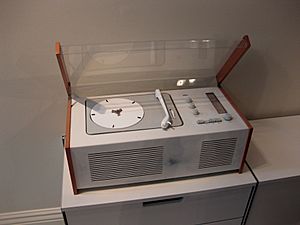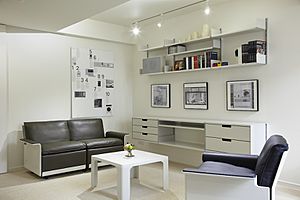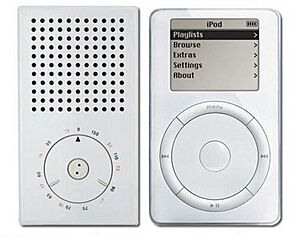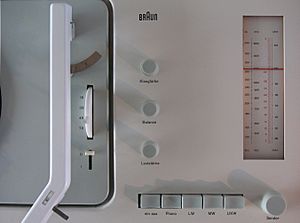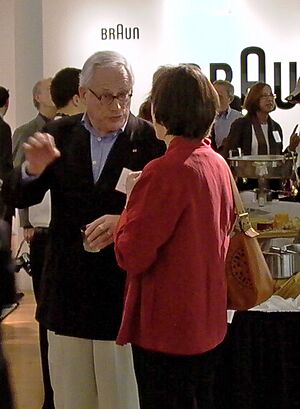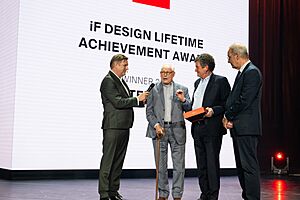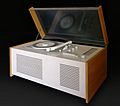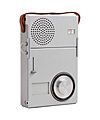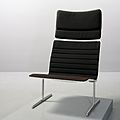Dieter Rams facts for kids
Quick facts for kids
Dieter Rams
|
|
|---|---|

Dieter Rams in 2010
|
|
| Born | 20 May 1932 |
| Nationality | German |
| Occupation | Industrial designer |
| Known for | Ten principles of "good design" Braun consumer products Vitsœ furniture |
|
Notable work
|
Braun SK 4 radiogram Vitsœ 606 Universal Shelving System |
| Spouse(s) | Ingeborg Kracht-Rams |
| Awards | Commander's Cross (Order of Merit, Germany) |
Dieter Rams (born May 20, 1932) is a famous German industrial designer. He is best known for his work with the electronics company Braun and the furniture company Vitsœ. Rams believes in a design idea called "less, but better" (in German, Weniger, aber besser). This means making things simple and useful, without extra decorations. His ideas have greatly changed how products look and work, influencing design for many years.
Contents
Early Life and Learning
Dieter Rams was born in Wiesbaden, Germany, in 1932. He started studying architecture and interior design in 1947 at the Wiesbaden School of Art. This school is now part of the RheinMain University of Applied Sciences.
After a year, he took a break to work as a carpenter and gain hands-on experience. He went back to school in 1948 and finished his architecture degree with high honors in 1953. After graduating, he worked for an architect named Otto Apel in Frankfurt. In 1955, when he was 23, the company Braun hired him as an architect and interior designer.
Designing a Career
Working at Braun
Rams joined Braun, a company known for electronics, in 1955. Six years later, in 1961, he became the head of design for the entire company. He kept this important job until he retired in 1997.
At Braun, Rams learned a lot from other designers like Fritz Eichler, Hans Gugelot, and Otl Aicher. They were all connected to the Ulm School of Design, which was a very important design school. Rams later said that their ideas helped shape his own work and the work of his team.
Rams and his team designed many well-known products for Braun. One famous item was the Phonosuper SK 4 radiogram, which was a radio and record player combined. People called it "Snow White's coffin" because of its clear, simple lid. This design was revolutionary because it made home electronics look modern and clean, not like old furniture. Rams's simple and user-friendly designs made Braun a very popular brand in the 1950s.
He also designed the T2 cigarette lighter in 1968. Rams insisted that Braun should design the technology inside the lighter, not just the outside.
Working with Vitsœ
In 1959, Rams started working with Vitsœ, a furniture company. This led to his famous 606 Universal Shelving System. This shelving system is still sold today, almost exactly as he designed it. He also created other furniture for Vitsœ in the 1960s, like the 620 chair collection. Rams worked with both Braun and Vitsœ until his retirement in 1997. He still works with Vitsœ even now.
Rams's Influence on Design
Dieter Rams's design ideas and style have had a huge impact on other designers. For example, Jony Ive, a top designer at Apple, was greatly influenced by Rams's work for Braun. Many Apple products look similar to Rams's designs.
For instance, Apple's calculator app on iPhones looks like Rams's 1987 ET66 calculator. The original iPod also looked a lot like Braun's T3 transistor radio. Rams himself said that Apple is one of the few companies that designs products using his principles. Jony Ive even sent Rams an iPhone with a letter thanking him for the inspiration.
Ten Principles of Good Design
In the 1970s, Dieter Rams thought about what makes a design truly good. He came up with his famous "Ten Principles of Good Design." These principles explain his ideas about how products should be made. According to Rams, good design:
- Is innovative – Design should always be new and creative, working with new technology.
- Makes a product useful – A product's main job is to be helpful. Good design focuses on how useful a product is.
- Is aesthetic – Products should look good. Beautiful objects are more enjoyable to use every day.
- Makes a product understandable – It should be easy to figure out how to use a product. The design should make its purpose clear.
- Is unobtrusive – Products are tools, not art. Their design should be simple and quiet, letting the user express themselves.
- Is honest – Design should not make a product seem better or more powerful than it is. It should not trick the buyer.
- Is long-lasting – Good design doesn't go out of style quickly. It lasts for many years, even in a world where things are often thrown away.
- Is thorough down to the last detail – Every part of the design should be carefully thought out. This shows respect for the person using the product.
- Is environmentally friendly – Design should help protect the environment. It should save resources and reduce pollution.
- Is as little design as possible – This means "less, but better." The design should be as simple as possible, focusing only on what's essential.
Exhibitions and Awards
Dieter Rams has been involved in design for over 70 years and has received many awards and honors.
Some of his notable awards include:
- 1968: Became an Honorary Member of the Royal Designers for Industry in the UK.
- 1989: Received an honorary doctorate from the Royal College of Art in London.
- 1996: Awarded the World Design Medal from the Industrial Designers Society of America.
- 2002: Received the Commander's Cross of the Order of Merit of the Federal Republic of Germany.
- 2013: Awarded the Lifetime Achievement Medal at the London Design Festival.
- 2024: Became the first person to receive the iF Design Lifetime Achievement Award.
Less and More Exhibition
An exhibition called Less and More showed many of Rams's famous designs for Braun and Vitsœ. It traveled to Japan in 2008 and 2009. It was also shown at the Design Museum in London (2009-2010) and the San Francisco Museum of Modern Art (2011-2012).
Rams Documentary Film
In 2016, filmmaker Gary Hustwit made a documentary film simply called Rams. The movie features deep conversations with Dieter Rams about his design ideas, how he created his famous products, and what inspired him. The film also helped to save Rams's important design archives.
Other Exhibitions
The Vitra Design Museum held an exhibition in 2016 called "Dieter Rams. Modular World," focusing on his love for organized shelving systems. In 2022, the Museum für Angewandte Kunst in Frankfurt updated its permanent display "Dieter Rams. A Style Room" to celebrate his 90th birthday. Another exhibition, "Dieter Rams. Looking back and ahead," has been shown in New York and Milan in recent years.
Images for kids
See also
 In Spanish: Dieter Rams para niños
In Spanish: Dieter Rams para niños


